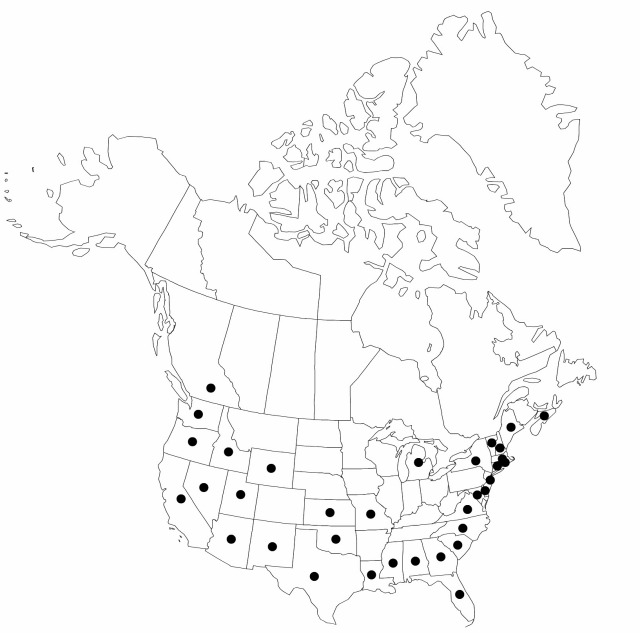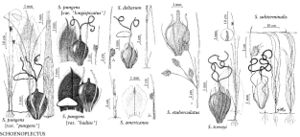Schoenoplectus americanus
Fl. Schweiz ed. 2, 1: 75. 1905.
Rhizomes 2–5 mm diam. Culms sharply trigonous, sides deeply concave throughout to rarely nearly flat, 0.4–2.5 m × 3–10 mm. Leaves ca. 3, basal, less than 1/2 culm length; sheath fronts not pinnate-fibrillose; blades 1–3, V-shaped near base, otherwise laterally flattened-trigonous in cross section; distal blade 0.2–1.5 times as long as sheath, 25–200 × 2–8 mm. Inflorescences capitate or very rarely with 1 branch to 5 mm; proximal bract usually erect, resembling leaf blade, 1–6 cm. Spikelets 2–20, 5–15 × 3–5 mm; scales bright orange- to red- or purple-brown to straw-colored, often partly translucent, usually clearly lineolate-spotted, broadly ovate, 2.7–4 × 2–3 mm, smooth or awn sparsely spinulose, margins deciduously ciliolate, flanks of proximal scale often with several ribs, apex rounded to acute, notch 0.1–0.4 mm deep, awn not contorted, 0.2–0.6 mm. Flowers: perianth members (2–)5–6(–7), yellow-brown, bristlelike, slender to stout, often unequal to equaling 1/2 achene body, retrorsely spinulose; anthers 1.5–3 mm; styles 2-fid or 2-fid and 3-fid. Achenes brown when ripe, thickly plano-convex or unequally biconvex or compressed obtusely trigonous, obovoid, 1.8–2.8 × 1.3–2 mm; beak 0.1–0.3 mm. 2n = 78.
Phenology: Fruiting spring–summer (south), summer (north).
Habitat: Brackish or mineral-rich shores, marshes, fens
Elevation: 0–2200 m
Distribution

B.C., N.S., Ala., Ariz., Calif., Conn., Del., Fla., Ga., Idaho, Kans., La., Maine, Md., Mass., Mich., Miss., Mo., Nev., N.H., N.J., N.Mex., N.Y., N.C., Okla., Oreg., R.I., S.C., Tex., Utah, Vt., Va., Wash., Wyo., Mexico, West Indies (Puerto Rico), Central America, South America.
Discussion
The secondary involucral bracts of Schoenoplectus americanus lack blades and closely resemble floral scales, in contrast to S. pungens and S. deltarum. Although mostly very locally distributed, S. americanus is ecologically important in many coastal marshes. In recent years it has seriously declined (e.g., in Maryland and Louisiana). It may occur in southwestern Kansas; I have not seen a specimen. It probably has been extirpated from the Missouri station, based on one collection from 1886 (G. Yatskievych, pers. comm.). The report from New Hampshire is based on M. L. Fernald (1950). The stations on the Maine and Connecticut coasts, at Lake Champlain in Vermont, and in Oklahoma are based on putative S. americanus × S. pungens specimens. Some plants in the southwest are atypical in having nearly flat culm sides and leaf blades to 1.5 times as long as their sheaths as in the type of Scirpus monophyllus J. Presl & C. Presl from Peru. The name Scirpes americanus was long misapplied to Schoenoplectus pungens; Schoenoplectus americanus was known as Scirpus olneyi (A. E. Schuyler 1974).
Selected References
None.
